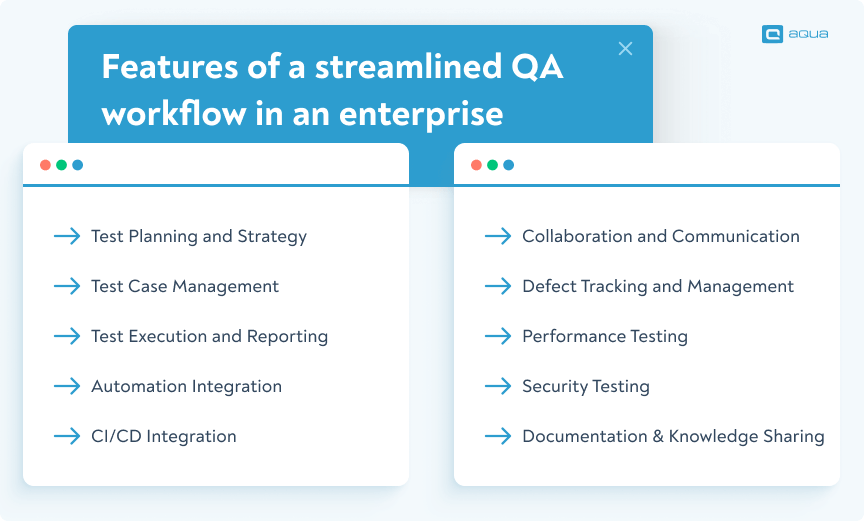Key aspects of testing in enterprise companies
Testing should be taken seriously in all spheres and companies, especially enterprises. According to a report by Statista, global spending on QA and testing services reached approximately $40 billion in 2020, and it is increasingly growing. Before implementing a robust QA workflow, you should ensure that software testing gets the attention it deserves. Here is why you, as a QA manager, should not let other professionals take QA lightly:
- Quality Assurance: Testing ensures that the software meets quality standards and performs as expected, helping build customer trust and maintain the company’s reputation.
- Risk Mitigation: Testing helps identify and mitigate risks early in the development process, reducing the likelihood of costly errors, security vulnerabilities, and compliance issues.
- Customer Satisfaction: By detecting and fixing defects before release, testing enhances the user experience, leading to higher customer satisfaction and retention.
- Cost Reduction: Early detection and resolution of defects through testing prevent the need for expensive fixes and rework later in the development lifecycle, saving time and resources.
- Compliance and Regulations: Testing ensures that software products comply with industry regulations and standards, reducing legal risks and potential penalties.
- Competitive Advantage: High-quality, reliable software products gained through thorough testing can differentiate a company from competitors, attracting more customers and increasing market share.
- Innovation Enablement: Testing provides valuable feedback on product performance and usability, enabling companies to innovate and iterate based on user insights and market demands.
- Continuous Improvement: Testing fosters a culture of continuous improvement by identifying areas for optimisation and refinement in the development process, leading to greater efficiency and effectiveness over time.
Of course, overlooking these aspects and points poses major risks for businesses of all sizes. However, the stakes are particularly high for enterprise organisations, where mistakes can be increasingly costly. Neglecting customer satisfaction might result in big losses, mounting in millions of dollars. Furthermore, violating compliance and regulations can devastate your business, no matter how big it is. This is precisely why, in today’s overview, we focus on the enterprise sector.
QA in the enterprise is not about mere functionality checks but about safeguarding the core of business operations. That is why having streamlined workflows and setup processes is crucial: it will help you deal with those risks and bring order to the existing chaos.
But how do you achieve this? In the next section, we focus on exactly what you need for a controlled, efficient and properly managed work environment.
Features of a streamlined QA workflow in an enterprise
Although the features of QA workflow in an enterprise can vary depending on the specific industry, company size, and project requirements, there is still a common ground for almost all of them. Below are some common features of a QA workflow in an enterprise. See if your workflow includes these:
- Test Planning and Strategy: Defining the scope of testing, determining test objectives, and developing a strategy to achieve those objectives efficiently.
- Test Case Management: Creating, organising, and managing test cases to ensure comprehensive coverage of the tested software.
- Test Execution and Reporting: Running test cases, documenting results, identifying defects, and generating reports to communicate findings to stakeholders.
- Automation Integration: Implementing automation tools and frameworks to automate repetitive and time-consuming test cases, improving efficiency and reliability.
- Continuous Integration/Continuous Deployment (CI/CD) Integration: Integrating QA processes into CI/CD pipelines to ensure testing occurs at every development and deployment stage, facilitating faster delivery of high-quality software.
- Collaboration and Communication: Effective communication and collaboration among team members, developers, stakeholders, and other relevant parties to ensure smooth coordination of QA activities.
- Defect Tracking and Management: Recording, prioritising, and tracking defects found during testing, and managing their resolution to ensure that software quality is maintained.
- Performance Testing: Evaluating the performance and scalability of the software under various conditions to ensure it meets performance requirements.
- Security Testing: Assessing the security of the software to identify vulnerabilities and ensure compliance with security standards and regulations.
- Documentation and Knowledge Sharing: Documenting QA processes, procedures, and test results and sharing knowledge and best practices within the team to improve efficiency and consistency.

Our workflow is pretty complex but it flexes up and down depending on client, size and scale etc. We have - and hear me out - To do - in dev - peer review - deploy to test - in test - deploy to uat - in uat - done.
Looking for a solution that will streamline your QA workflow in an enterprise? We introduce you to the ultimate QA management tool – aqua cloud. aqua’s AI-driven capabilities automate manual tasks and reduce human errors across the test life cycle, ensuring efficiency and accuracy. By bringing structure to chaotic QA work, aqua cloud eliminates disjointed testing data and streamlines workflows for maximum productivity. Gain full visibility into your QA process with aqua testing tool, overcoming the confusion of tracking testing items and projects. Our intuitive interface enhances user experience, facilitating seamless collaboration and communication among team members. With aqua, you invest in comprehensive testing capabilities that ensure the quality and reliability of your software products. Ready to streamline the testing workflow in an enterprise with a few clicks?
Save at least 60% of your QA management time with an AI-powered solution
QA tools for enterprise-level testing
If you want to streamline your QA workflow, having an all-around solution is a must. In a few years, no one will manage their QA processes manually. Want to have an edge and be a few steps ahead? Here are some enterprise QA tools you should consider for your enterprise-level QA activities:
- aqua cloud: A cutting-edge test management and automation platform tailored for enterprise-level testing, leveraging AI technology to streamline workflows and enhance efficiency. With aqua, you can expect comprehensive test case management, seamless integration with CI/CD pipelines, and full visibility into the QA process, all while avoiding the inefficiencies of traditional testing methods.
- Jira: Jira, which offers robust project management and issue tracking capabilities, lacks out-of-the-box features for setting up a streamlined QA workflow. However, when integrated with a dedicated QA solution like aqua cloud, Jira’s capabilities can be enhanced, enabling you to achieve maximum effectiveness in managing software releases. Jira’s licensing costs may also be prohibitive for large-scale enterprise deployments, potentially limiting accessibility for smaller teams or projects. Despite these limitations, with the right customisation and integration, Jira can still serve as a powerful tool for release management, especially when paired with additional QA solutions to fill in any gaps.
- Micro Focus ALM/QC: Micro Focus ALM/QC provides robust test and requirements management features. However, its user interface can be complex and overwhelming for new users, requiring extensive training and onboarding. Micro Focus also lacks a lot of desired integrations, including Jira.
- Ranorex Studio: Ranorex Studio offers powerful test automation capabilities, but its licensing model may not be cost-effective for all enterprise budgets, particularly for organisations with many testers or distributed teams.
- Qmetry: While Qmetry provides comprehensive test management and automation features, users may encounter challenges with performance scalability in very large enterprise environments, potentially leading to slower test execution times and resource constraints.
So, you should be careful when choosing the tool that fits your needs and desires. Checking review platforms and reading testimonials will help you a lot in that journey.
Best practices for tool integration
Okay, let’s say you choose aqua cloud from this list. How can you integrate it seamlessly into your existing toolchain for maximum efficiency? Below are some best practices for tool integration:
- Define Clear Objectives: Clearly define your integration objectives, such as improving collaboration between teams, automating workflows, or enhancing visibility into testing processes.
- Assess Compatibility: Evaluate aqua’s compatibility with your existing tools and systems, ensuring smooth integration without disruptions to your current processes.
- Implement Automation: Automate repetitive tasks and processes by integrating aqua with CI/CD pipelines, version control systems, and test automation frameworks, reducing manual effort and improving efficiency.
- Establish Data Synchronisation: Ensure data consistency and accuracy by synchronising between aqua cloud and other tools, such as requirements management systems, defect tracking tools, and project management platforms.
- Provide Training and Support: Provide comprehensive training and support to your team members on usingss integrated tools effectively, empowering them to leverage aqua’s full potential within your toolchain.
- Utilise APIs: Use aqua cloud’’s APIs to integrate with other tools and systems in your ecosystem, enabling data exchange and automation of tasks across platforms.
So what are you waiting for? Here is the solution for your enterprise’s requirements management, test case management, and overall QA chaos. With aqua cloud, you’ll gain control over your QA processes like never before. Say goodbye to the chaos of disjointed testing data and manual workflows. aqua offers a centralised platform for requirements management, ensuring alignment with project objectives and streamlining the creation and execution of test cases. Our AI-powered solution leverages context and semantics to automate repetitive tasks, saving you time and reducing errors.
Take charge of your QA workflow with a few clicks
Conclusion
We’ve explained the importance of cohesive QA process in enterprise, and if you’re willing to step into a world of streamlined efficiency and unparalleled control, consider aqua cloud. Picture this: gone are the days of managing chaos between multiple tools and systems. Instead, imagine a single, all-encompassing platform where requirements management seamlessly flows into test case creation, execution, and beyond. Ready to revolutionise your QA processes with an all-around tool? Do not wait; contact us to take the pain of testing away from you.







